California Café is a popular hangout in Huaraz, just south of the main square, attracting visitors from all parts of the world. They serve breakfast and lunch, and you can relax there from early morning until late afternoon, read one of the books from their small but fine library, or swap stories with fellow travelers.
On one of my visits I met a band of three mountaineers from the Balkans. Like me, they were on a climbing trip to the Cordillera Blanca, and we started talking. They were long time friends, with varying degrees of mountaineering experience. One of them couldn't stay as long as the others, but they would start out together, and then continue later as a two man team.
I met them again in the Ishinca refuge. I was there with Eric, to have a go at
. They were on the last leg of their adventures as a threesome, and had just climbed Ishinca – where one of them had ended up dangling in the bergschrund just below the summit. It must have been scary, but it had not been really dangerous; they had just started their descent and he was on belay.
After that, we went our separate ways again – until well over a week later, when, by chance, we met once more in Huaraz. In the mean time, I had climbed
, but he had decided not to climb Chopicalqui, our next goal, so I was on my own again.
They were one man down too, as the third member of their group had left. Shakshama, originally from Macedonia but dividing his time between his home country and New York, was an experienced mountaineer. In contrast, Angikar, from Serbia and also part time New Yorker, was new to the game. They had been close friends for 20 years, and finally Angikar got infected by his friend's climbing bug. And now he was about to jump in it at the deep end, for they had set their sights on Huascarán Sur!
Eager as he was, he was well aware of his limited experience, and, understandably, felt a bit apprehensive at the thought of crossing the glacier with only one other climber on the rope, even if it was a very experienced one like his friend. And while Shakshama didn't give the impression that he shared Angikar's trepidation, he certainly was sympathetic to his doubts.
As it happened, I was approaching the end of my extended trip to Peru, and I still had not succeeded in climbing Huascarán Sur. In fact, I had already been looking for a partner for it, or, if I couldn't find one, hire a guide.
It was an easy decision. We got along fine so far, and so we joined forces. With three people on the rope, crossing the glacier would be much safer, and Angikar wasn't worried anymore.
). Back then I climbed with Lyngve, an experienced mountaineer from Norway. We wanted to climb both Norte and Sur, but it didn't quite go according to plan. First the altitude got the better of Lyngve, then later the weather worked against us.
The day after arriving at high camp, or Campo Dos as it is commonly known, Lyngve wasn't feeling all too good, so he rested. It was pretty windy too. By the time we had daylight, I headed out on my own to scout part of the route on Norte. Although I realized it was a possibility, I didn't expect to summit. However, the climb was going well, and so, somewhat to my own surprise, I scouted all the way to the top!
The next day Lyngve felt better, but visibility was worse. The base of the clouds was only a few hundred meters above us. Nevertheless we headed out together to climb Sur, hoping for improvement. It didn't happen. The clouds didn't disappear, and we didn't stand a chance. Still, it had been a memorable short expedition – and I was proud to have summited Norte, on my own no less. But I still wanted to climb Sur.
I had learned a thing or two on my first visit. I knew the route up to around 6300m, the camp sites, how to get to the mountain and who to ask about mules and porters to carry our heavy bags part way up the mountain.
Since we were all acclimatized well enough, we skipped base camp (4200m) – which, by the way, may be in a very scenic spot, but at the same time is home to some unpleasant biting insects, which makes it hard to enjoy these views. My advice? Don't stay there unless you have no choice.
Five hours after we had departed from the trail head at Musho (±3100m), we arrived at the refuge (4650m). Shakshama was fine, but Angikar was tired. I was hoping he would be fine again tomorrow: it wouldn't be a long day, but we had no porters anymore, and for the first time we would be carrying all our gear ourselves - minus what we would leave at the refuge, that is.
From the refuge, it's not far to Campo Uno (5300m), the last flat area on the glacier below the dangerous icefall. In fact, if you are well acclimatized and in good shape, you can make it from the refuge to Campo Dos (5850m) in one day. But we were in no hurry, and spending another night at 5300m should improve our chances.
With plenty of time, we enjoyed a leisurely breakfast in the refuge before heading out. As we were making our way up, we encountered several groups of climbers and porters on the descent. For various reasons, none of them had made it to the summit, which wasn't too encouraging. Nevertheless I was optimistic about our chances: we were reasonably well acclimatized and we brought a lot of of spare food to stay on the mountain a few days longer if necessary.
At the edge of the glacier we had our lunch break. A Belgian climber, a guide and two porters passed us. They were also on their way to Campo Uno, but they had spent the night at base camp. I didn't quite understand why climbers would want to skip a perfectly fine refuge. Is it the cost? Sure, for Peruvian standards it was expensive, but from a Western point of view it wasn't. And if they were acclimatized enough to go straight from base camp to Campo Uno in a single day, it would make much more sense to skip base camp and stay at the refuge, like we did – or, if you wanted to save a bit of money, camp somewhere close to it for free.
Even before we were on the move again, another group on the way up passed us. We stuck to our plan of taking it easy today, and so we were the last ones to arrive at Campo Uno. It was a big area, but for some reason the tents were pretty close together. We moved on just a wee bit past them, to have some privacy, and after a little bit of work with our axes to create two flat spots, we made our camp away from the rest.
My newfound friends have a small single wall tent. Light, sure, but it suffers from condensation problems. They also have simple mats, one foam and one inflatable between them, and relatively light sleeping bags. In contrast, despite the weight, I've dragged up my bigger double wall tent, Exped down mattress and warm sleeping bag. I strongly believe in the importance of sleeping well before climbing…
![In the icefall on Huascarán]() Between Campo Uno and Campo Dos
Between Campo Uno and Campo DosThe cold morning and my friends' not overly warm gear makes that we're not eager to get up early. Instead, we wait until it is a bit less cold before setting off.
The first hour we are making good progress, but then Angikar starts to get tired. As Shakshama and I are in better shape, Angikar sets the pace for all of us. However, he is still learning how to keep a slow but steady rhythm. Not surprisingly, he goes too fast when he starts moving after a break, which means he frequently needs to stop again to catch his breath. Still, we're not doing too badly and gradually we get higher.
At first, the route winds its way around crevasses. There are a few steeper sections too, but nothing serious. It's different once we get higher. Technically it's easy now, but the route traverses below a couple of avalanche zones, and the debris is clear evidence of the danger. This is no place for a break, so we push a bit harder now.
![Dangerous crevasse high on Huascarán]() There are a lot of crevasses, small and big, along the route to Campo Dos
There are a lot of crevasses, small and big, along the route to Campo Dos
While Campo Dos is visible from far, far below, there is a low ridge on the route right before reaching it, hiding it from sight, and so it comes as a bit of a surprise when we suddenly see the welcome sight of a couple of tents right in front of us.
I meet a few other climbers, porters and guides, and even a cook. Shortly after our arrival, two Czechs are coming down. They had set out at 2 am, but once they got to Garganta, the huge 6000m col between Norte and Sur, they could not find the route up, so they waited for sunrise before continuing. Having been there before, I sympathize with them. Depending on the conditions, from Campo Dos to the center of the col does not take much more than an hour, so they must have waited up there for a long time! It must have been a really long and cold night. Fortunately, their persistence paid off, and they got their reward when they made it to the summit after all.
![Ice formations on Huascarán]() Ice formations along the route to Campo Dos
Ice formations along the route to Campo DosShakshama, Angikar and I decide on a 4 am start. That should give us enough time to descend part of the way to the refugio after our summit push, should we still have the energy for that. Not that we have to, we have enough supplies to stay up here much longer. Talking to the guide of the Belgian climber, I learn that they plan to start at 4 as well.
Stove trouble
Right before heading out, I had bought a brand new stove in Huaraz, an MSR Dragonfly. I had practiced using it in town, and it had worked fine in Campo Uno too, but now, for some reason, I couldn't get it started anymore. I kept trying and trying, but it just didn't cooperate. I couldn't figure out what I was doing wrong. The guide, having noticed my fumbling, kindly offered to use the equipment at their camp. I gladly accepted.
As it turned out they had a big stove with a massive butane tank! I suppose it's cheaper to pay someone to drag such a monster up the mountain than to buy lightweight gear… Anyway, it worked like a charm, and soon I was happily cooking dinner. In the mean time, the guide and some of the porters tried their hand at my stove, but to no avail. When they gave up, I resumed my own attempts. I didn't have much else to do anyway while I was melting snow.
The first phase, pre-heating, seemed to be working, but the transition to a proper blue flame never properly materialized. At best, it just held on for a few seconds before it died out. Then, after many attempts, and without knowing what I had done differently, at one point it finally kept burning! Now I had two good stoves at my disposal, and melting snow was twice as fast.
In the back of my mind I had some nagging doubts about my stove, worried that I still didn't know the trick, if there was one, to light it. Would I be able to get it running again tomorrow? Sure, Shakshama and Angikar had a stove too, but it wasn't as fast, so if it came down to it, it would take a lot of time to cook and melt snow for the three of us. Ah well, nothing to be done about that right now - and on that note we went to sleep.
Summit day
3 am
Wake up time.
From his tent, Shakshama shouts that Angikar is not feeling well. He proposes to wait an hour before deciding what to do next. That seems rather short to me, so I counter with a proposal of two hours.
5 am
Angikar isn't feeling any better. We decide to wait two more hours. I'm not tired, so instead of going back to sleep, I start having breakfast.
Almost 8 am
In full daylight, we can see that the conditions on the mountain are excellent. I'm just about ready to set off, when Angikar comes to ask if I have any medicine against stomach problems. He is in no shape to climb anything. I don't have anything strong, just Loperamide, of which I give him a good supply.
Then I discover that there has been a communication error a couple of hours earlier. I must have misunderstood Shakshama, because I'm under the impression that, after our two postponements, we would leave at eight. However, when I appear at his tent, he is far from ready. Surprised by the fact that I am ready to go, he now has to make up his mind quickly.
I reckon, should the weather still be good tomorrow and Angikar feels better, the three of us will simply do it all over again, so Angikar will have his summit too. Shakshama and Angikar don't think that this plan would work, they think it will take one or two days to recover from a successful summit bid. I can't speak for others, but, knowing how quickly my own body recovers at altitude if I don't overdo it, I have no such reservations myself.
Shakshama briefly considers his options. He decides to stay with his friend. He was sick, and, quite understandably, staying with him was more important than a possible summit.
That means I'm flying solo – again. Now, when I set out for Norte a month ago, I planned to scout part of the route, but only thought it a remote possibility that I would get even close to the summit. This time however, with Norte in mind, it is different. I still don't think I can go all the way, but from the outset I know that it is at least a real possibility.
The provisional plan is to go as far as just above where I was forced to return the last time, because the clouds made the route invisible back then. Higher up, the route should be easy, but I also expect there are more crevasses up there, and the risk of falling into a hidden one will probably make me turn back. Besides, starting much later than usual means I may well run out of time. But, notwithstanding all these reservations, in the back of my mind I'm thinking (and fervently hoping) that it will all work out.
Terrain map of Huascarán. The green paddle points at Campo Dos. Garganta lies to its northeast, and the summit of Sur is in the lower right corner. Roughly speaking, from just south of the highest point of Garganta, the route aims directly for the summit. Not that it was possible to see that, because, as the contours illustrate, the face of Sur above Garganta is much steeper than the final summit area.
![View of the Cordillera Blanca]() Quitaraju, Alpamayo and Artesonraju, seen from high on Huascarán Sur. On the left is the sheer East ridge of Norte.
Quitaraju, Alpamayo and Artesonraju, seen from high on Huascarán Sur. On the left is the sheer East ridge of Norte.In a steady pace I make my way up. Soon I get to Garganta, then onto the steep and convoluted glaciated slopes east of the summit plateau. Unlike the last time I was here, the skies are clear and it's a very bright day. Conditions could hardly be any better!
![A hole in the ice on Huascarán Sur]() A few hundred meters above Garganta
A few hundred meters above GargantaAt the crux
In a few hours I get to the point where I had to turn back before, because I simply could not see where the route went. This time it's clear though: I spot an orange route marker high above me, and I see small pieces of snow and ice trickling down, the clear signs of other climbers higher up. It's steep, up to about 60º. But although the grade is daunting, it's hard packed snow, my favorite climbing surface. I feel confident, trusting my two ice tools.
I start climbing. Staying a few meters left of the fall line of the bits of snow and ice, I make my way up. I focus on my technique and I go slow, to make sure I won't run out of steam. When I'm almost at the top – it must have been between 60 and 80 meters high – I see two other climbers, one of which is just about starting to rappel from a snow anchor that must have been left there by a previous party. Seeing a lone climber coming up there must have surprised them…
They tell me that the rest of the route to the summit is easy and they saw few crevasses, but it's also very long – they had needed 3½ hours for it! I like the news, although it is a mixed blessing: the first part is very encouraging, but as it is almost 12 o'clock already, and with sunset shortly after 6, I can't afford to take 3½ hours to get to the summit. But I'm optimistic, and hope to do it faster. It may be a long walk, but it's only 400 meters or so higher now.
The long slog
I figure, I don't need to worry about the time right now, I'll do that later if I have to. I'm happy that I can continue, enjoying the relative safety of a clear trail. I suppose there are still some hidden crevasses, but wherever the trail crosses them, they are more than likely to be covered by more than just a thin layer of snow, or someone would already have broken through.
I'm feeling fine, as if the altitude doesn't affect me, but even though the glacier isn't steep anywhere, and sometimes even almost flat, the lack of oxygen really slows me down. It's so easy to underestimate the full impact of low oxygen, and acclimatization can only compensate so much. When I looked it up later, I learned that a breath of air at the summit of Huascarán only has 44% of the oxygen compared to a breath at sea level. When you think about it, it's remarkable we can stay alive at that altitude at all! Then again, one of the effects of low oxygen is that you're not thinking quite as clearly anymore…
![Huascarán Norte from high on Sur]() It's good to look back occasionally...
It's good to look back occasionally...
I'm high on Huascarán Sur, around 6600 m or so. That's almost as high as Norte, which is what I'm looking at. It may look small, but make no mistake about it: that face is 650 m high!
It's a month now since I climbed it. Not by this face though, I don't have a death wish. No, I climbed the normal route, which is the south ridge, coming from the left in this photo.I don't stand still though; blissfully ignorant of these reflections, I keep going up. I can already see the summit in the distance. It doesn't look impossibly far at all, I can do that! However, as usual, distances in the mountains are deceiving and it takes longer than expected to get there. And then, as I finally get close, another summit just pops up above it! I shift gears and mentally adjust to a longer climb. Doggedly I plod on. As before, the grade varies between almost flat and a gentle incline. Fortunately it's never downhill, so I don't lose any altitude. But I'm unlucky once again: the second summit proves to be a false one too. I'm starting to run out of time, but I'm still unwilling to give up. The terrain is so easy, and it's
got to be close now!
I consider persistence to be one of my strong suits – but at the same time I know it may get me in serious trouble one day, since it means I'm a poor judge of the right time to turn around. Do I perhaps suffer a bit from summit fever?
Fortunately, the third apparent summit proves to be the true one. It's a big area, and there is nothing higher lurking behind it this time. As I look at my watch, it's 15:26 when I reach the summit. I've been climbing for 7 hours. That's a pretty decent time, but it's far too late now to stay and enjoy it for long. A minute later I'm on my way down.
While it may have taken a long time to climb the gentle slopes above the steep crux, the same grade now comes to my aid. The big summit itself is virtually flat, but after a few minutes it gets a bit steeper. I sit down, push off, and start sliding. It's the perfect grade for it: I lose altitude fast, but it's not steep enough to have to worry about losing control. Walking down the flattish parts and glissading the somewhat steeper ones, I'm back at the top of the steep slope in no time at all.
The most dangerous part
I know that this is the crux. If I get down this slope safely, I'm home free. To be fast, I've been climbing with as little gear as possible, so, without a rope, the snow stake is no use to me. I have to climb down the 60º slope. It's no surprise of course, I was fully aware of it when I climbed up. But climbing down is harder than up, and I'm a bit more tired now, and with those two facts, I realize that this is the most dangerous part of the whole climb.
After a short breather, I concentrate, then I go to work. There is no margin for error, falling is not an option. Facing the mountain, I place my two axes in the snow, close to the edge. I take one step over the edge, kicking my crampon firmly in the snow of the steep slope below - and then I take another. I'm on my way.
Keeping three points of contact at all times, I methodically descend. I place my left foot lower, then the right one. Left axe lower, right axe. Over and over I repeat the cycle. I monitor my breathing, remind myself to go slow, and focus on my technique. Everything is going smoothly, and I'm a happy climber.
Some 50 meters below the edge, I get a surprise: I encounter another snow stake! It's partly hidden in the snow, and it clearly hasn't been used for a while. And as it isn't quite as steep here as near the top, I can understand why. Sure, it's still safer to rappel a second time from here, but as it is less difficult to climb down now than it had been higher up, I suppose many climbers will probably have climbed down from here, rope or not. I'm not out of the woods yet though: lower down a big crevasse is waiting to catch out any unfortunate climbers. Falling is still no option, I must stay focused. And so I continue my descent, until, after a short traverse above the crevasse, I reach easier ground again and can finally relax.
Am I in trouble?
A bit further down the route comes to another steep slope. It's much shorter this time, and no more than 50º. And, perhaps
because it was easier, I make a mistake – I go down too far.
At the bottom, I cross a small bergschrund to reach a flatter area. I stop to look around for the next trail marker. Usually it's possible to see the next one, but this time I draw a blank. So, instead, I just follow the trail at my feet. A few minutes later, I know I'm off route. The vague trail I'm following goes down steeper and steeper, and eventually fades away. This isn't how I had come up!
I retrace my steps for a while – which is tiresome, as it means I have to go back up again. I still don't see any markers, but going down is easier than going up, so I don't go up very far before trying a different way down. As before, it starts as a trail, but before long it disappears. It isn't really steep this time, but to get further down, to the relative safety of Garganta, I find my way blocked by huge crevasses everywhere. Perhaps it would be possible to rappel somewhere, but without a rope I don't have that option so I'm not even looking for it. My only way out is to find the route again.
While I'm searching, I'm losing precious daylight. The thought of having to spend the night out there enters my mind. I'll have to fashion a snow hole and wait for 12 long hours, without water or food. That will be uncomfortable, but I can do that. More importantly, I don't have my warm sleeping bag with me. Climbing light meant I counted on getting back to my tent. If I don't, I have to stay awake all night, hoping my down jacket will be up to the task of keeping me warm, moving about and wiggling my toes to avoid frostbite. And my mittens are not too warm either. I'm feeling a bit stupid, getting myself in this predicament. I
never get lost! And it shouldn't have been hard at all, after down climbing the hardest part!
![Ah, there is a route marker again - now how do I get there?]() As it happened, on the way up I had taken a photo just below where I got lost. You can see the small orange route marker here. Going up, the trail goes to the left, around the corner. Going down, I didn't see the route marker and therefore I didn't turn around this corner.
As it happened, on the way up I had taken a photo just below where I got lost. You can see the small orange route marker here. Going up, the trail goes to the left, around the corner. Going down, I didn't see the route marker and therefore I didn't turn around this corner.Instead of trying to follow more vague trails, I take stock of my situation. I have a headlight, and I know that as long as I get close to Garganta, that's enough to make it back to my tent. And my best chance of making it down there is by following the normal route. So, how do I find it again?
The conclusion is obvious. I have to go back up, as far as it takes, to where I'm sure I'm on the route – that is, to the last trail marker. From there I'll start the search for the next one down. It's hard work to go up, but I tried going down and that had not worked. The only way is up. Now that I know what I have to do, I'm focused again.
Sure enough, shortly after climbing above the schrund at the base of the 50º slope, I see where I had gone wrong. On my way down, while still above the schrund, I should have traversed to the east, a bit around the corner. I can see the next route marker nearby, and even the trail is obvious now that I know where to look. I suppose that the reason I missed it earlier was that it just seemed so obvious to descend the whole slope, to the easy ground below the schrund – and the false trails testified that I wasn't the first one making that mistake!
![Wild ice high on Huascarán Sur]() I'm not not far above Garganta anymore. I didn't take many pictures today, but the hard part is over and I can relax a bit now.
I'm not not far above Garganta anymore. I didn't take many pictures today, but the hard part is over and I can relax a bit now.Now that I'm on the right track once more, I soon make it down to Garganta. I even have time to take a few pictures of the pink glowing slopes of the mountain. Only minutes after sunset I'm back at Campo Dos.
My first stop is Shakshama and Angikar. They are happy to see me back safely, and congratulate me on reaching the summit. Angikar is still sick though.
All along the climb, I had paced myself – getting exhausted is a recipe for disaster, especially when climbing solo. That, plus undoubtedly a bit of adrenaline, means I still have some energy to spare. To my relief, I easily get my stove running. The next few hours I spend on dinner and melting a whole lot of snow.
I drink a lot, because I had saved on weight by bringing along little water on the climb. But weight is of no concern anymore and in addition to what I'm drinking right away, I melt three more liters, to drink during the night, for breakfast and for climbing the mountain again tomorrow. It's 9 o'clock by the time I turn in. If Angikar feels better, we plan to leave at 4.
As soon as I hit the sack, the wind starts to pick up…
![Norte's shadow and alpenglow on Huascarán Sur]() Alpenglow on Huascarán Sur, seen from Garganta. The shadow of Huascarán Norte is on the left. Mind you, being at 6000m without shelter when the sun is about to go down is not ideal. In the thin air, the temperature will drop fast very soon. Fortunately, high camp is just below the saddle. Even in darkness I would be able to find it from here.
Alpenglow on Huascarán Sur, seen from Garganta. The shadow of Huascarán Norte is on the left. Mind you, being at 6000m without shelter when the sun is about to go down is not ideal. In the thin air, the temperature will drop fast very soon. Fortunately, high camp is just below the saddle. Even in darkness I would be able to find it from here.Rest day
3 am
Shakshama has trouble to make himself heard over the noise. Eventually I understand that Angikar is still too sick. But at that point, even if he had been feeling better, I know that the wind is too strong to have a fair chance of making it to the top.
10-ish
We discuss our options. The wind is still strong, but not as bad as before. Angikar isn't up for it, and it is too late for Shakshama and me to make it to the summit together. However, I suggest that if the wind dies down a bit more, the two of us can head out and explore the lower part of the route. That way, Shakshama will learn it too.
The wind cooperates, and not much later we are on our way. As we leave, I tell Angikar that we plan to climb for 3 hours, and then we will return: I want to show Shakshama the route up to the bottom of the crux, because with good visibility route finding will be easy from there, and without it the climb ends right there, just as I had learned the hard way on my first attempt.
Reconnaissance
From Campo Dos, we climb for half an hour. I let Shakshama take point, so he learns the route. Together we cross the huge crevasses at the edge of Garganta. It's a big plateau – well, not completely flat, but close enough. With the huge bulk of Norte and Sur on either side, it can be a bit of a wind tunnel. I know that once we get close to the face of Sur, the wind will almost be gone again, but in these conditions it will take the better part of an hour to get there.
![It's cold and windy on Garganta, the Huascarán col - let's go to a warmer place.]() It's cold and windy on Garganta, and so we return to Campo Dos
It's cold and windy on Garganta, and so we return to Campo DosWearing goggles and sporting a wild four month beard, I'm well insulated against the strong cold wind, but Shakshama is suffering. Besides, he has not eaten very much at breakfast – high altitude can quickly take away your appetite – and as a result he isn't feeling all to energetic. And so, a bit to my surprise, he decides it's better to turn around. An hour after our departure, we're back in camp.
It seems as if I spent the rest of the day cooking, eating, melting water and drinking. I finally figure out the trick to get my stove working at this elevation: It just needs a longer pre-heating period. Now that I've got the hang of it, I really love my stove. Sure, it makes an enormous noise, and I do not trust it to be safe to operate inside a tent, but it is very fast. And since I'm so happy that it works well now, I melt a whole lot of snow for my friends too.
For some reason, my wrist feels sore. My tent is not on pitched on a perfectly flat spot, which limits my sleeping positions – maybe I have lain on top of my wrist while I rested? I'm worried that it might hamper my climbing, and mention it to Shakshama. Hoping that Angikar will feel better, the plan is to leave at 2 tonight, which means a couple of extra hours to reach the summit. As I turn in around 8, I don't quite feel up to joining them, and tell them so. I have a few hours to sleep on it and reconsider.
Laying in my tent, I must admit that I'm a little worried about the prospect of them going out there. Earlier on, after our short excursion and personally experiencing the conditions on the col, struggling against the cold wind at 6000m, Shakshama had tried to persuade Angikar to descend right away instead of spending another night at Campo Dos. However, despite his illness, Angikar wasn't ready to give up on the mountain just yet.
I'm not worried about Shakshama; he has enough experience. But Angikar is a different matter. He is so keen to climb the mountain, I think that he may want to head out as soon as he feels better, even if not having eaten for days means he won't be in any shape to climb. Now, if he were to realize that quickly, there won't be a problem, but he has a lot of mental strength and I'm afraid that he may push himself too far… what if they climb above the first difficulties, and then he gets so exhausted that he cannot safely descend anymore? Or worse, what if they manage to climb the crux, and go on because it's so much easier after that, but then get so slow that they get stuck up there in darkness? I know that Shakshama understands these risks, but Angikar doesn't appear to. Hopefully he will listen to his friend in time. I didn't think that summit fever was contagious, but perhaps it's different here, and I've infected Angikar with it, it may be hard to persuade him to go down…
Around 9 the wind picks up again. On the one hand, I feel sorry that my friends may not even get a chance at the summit, but at the same time I'm relieved, knowing that this means that Angikar cannot start his dangerous summit attempt. And on that thought I fall asleep.
Starting our descent
2 am
![Ice formations on Huascarán]() Wild formations in the icefall between Campo Uno and Campo Dos
Wild formations in the icefall between Campo Uno and Campo DosI wake up from my slumber. Occasionally I can hear voices over the wind. Shakshama and Angikar, obviously, but I can't hear what they are saying. I must be sleepy, not realizing they would not speak English in the first place. I assume that they will wait for the wind to die down, and quickly fall asleep again.
First light
Somewhere between 6 and 7 I wake up again. Shakshama is shouting something. How long do I need to pack up, so that we can descend?
My watch has a thermometer, and it says it's –8º C inside my tent. It's light outside, but Campo Dos lies in the shade of Garganta. As I had learned yesterday, it takes hours before the warm rays of the sun will actually hit my tent and until then it's going to feel pretty cold. If Shakshama hadn't called out, I would gladly have stayed in my sleeping bag until 10 or so. On the other hand, if we want to descend all the way to Musho, I estimate that we should be leaving no later than around 10. As a compromise, I answer "9 o'clock"? "Ok", Shakshama replies.
Around a quarter to 9, all I have to do is pull down my tent, put on my crampons and I'll be ready. But our short sentences have lead to a misunderstanding. Instead of leaving at 9, they apparently think that we should only get up by then. Ah well, no problem. At least it will get warmer soon now.
Two hours later we are on the move. I know that unless we descend a whole lot faster than I anticipated, we have little chance of making it to Musho. As it happens, we do indeed make good time, but not good enough. At the edge of the glacier, Angikar and I are both in favor of spending the night at the refugio.
![A cairn along the way to the glacier]() One of the many cairns
One of the many cairnsOn our way up, between the refugio and the edge of the glacier, we had encountered a few places requiring the use of hands. Nothing serious, but hoping to find an easier way down, Shakshama opts for a slightly different route down, and we follow him. There are cairns all over the place, marking all sorts of route variations, but as long as visibility is halfway decent, you can see the refuge from far away, and choose your own way.
A little bit further down, I don't like where Shakshama is headed, so I take a different course. While occasionally using my hands, I find the going easy enough. At one point, looking around for my friends, I see them in the distance, still a bit higher. It looks as if Shakshama is considering a dangerous climbing move. Angikar looks at him, but makes no attempt to follow. Fortunately, Shakshama doesn't try it.
![Shakshama is trying to do it the hard way]() Shakshama is on the verge of descending the hard way - fortunately, he reconsiders
Shakshama is on the verge of descending the hard way - fortunately, he reconsiders![Refugio Don Bosco Huascarán]() Refugio Don Bosco Huascarán
Refugio Don Bosco HuascaránLater, he explains that he thought about lowering himself from the small ledge he was on, then hang by his hands on the edge. From that position he thought he could let go and land safely on another small ledge further below. I wasn't too close, but even from my distance it looked like a dangerously long drop. Fortunately, the 20kg on his back makes him reconsider and he goes back up to look for an easier way.
Without further incident, we reach the refuge.
![Sunset on Huascarán from the refugio]() Sunset on Huascarán from the refugio
Sunset on Huascarán from the refugioHuaraz
![Huascarán Norte]() Looking back at Huascarán Norte, not far from the trailhead at Musho
Looking back at Huascarán Norte, not far from the trailhead at MushoOn the last day, we don't have far to go, so we take it easy and leave the refuge late. After descending for a while, Shakshama gets in trouble with his toes, and soon after Angikar does too. It's no wonder, really; they are descending on trainers. A week before, when they packed, they planned to carry everything themselves all the way – they only changed their minds in Musho – and so, apart from their heavy boots, trainers were all they brought. And that's not ideal footwear to descend more than 1500m on a steep mountain trail.
Still, as it is the last climb of their trip, they won't need their toes very much the next couple of days. A little damage won't be a problem. Without serious complications we safely make it down to the trailhead, and before nightfall we are back in Huaraz – where a hot shower, fine food and a warm bed are waiting.


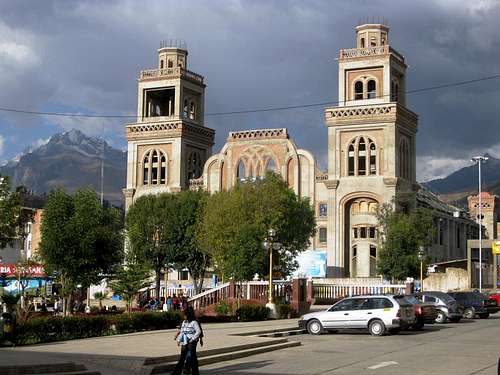
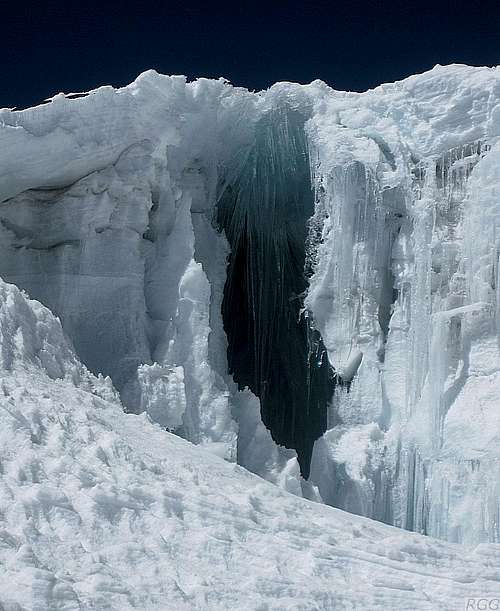
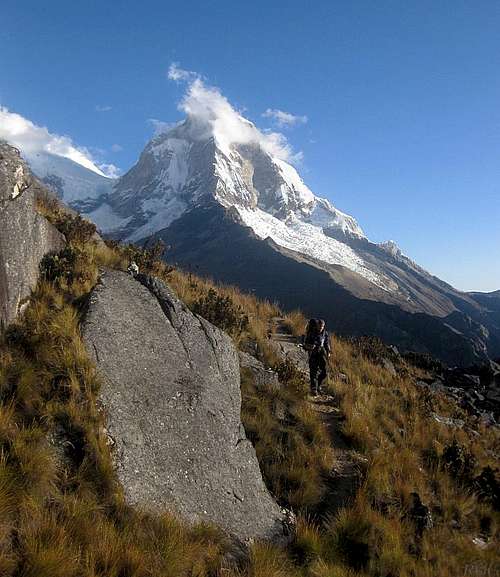
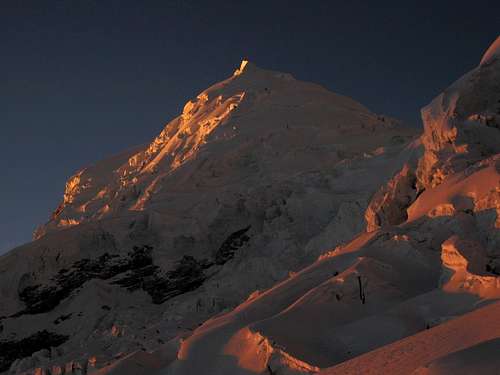
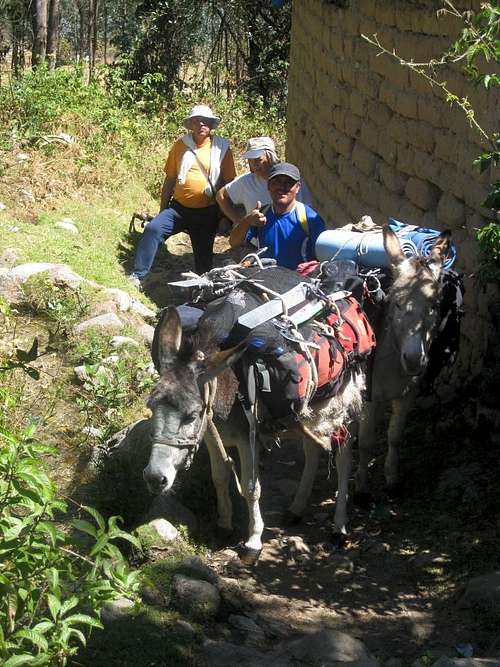
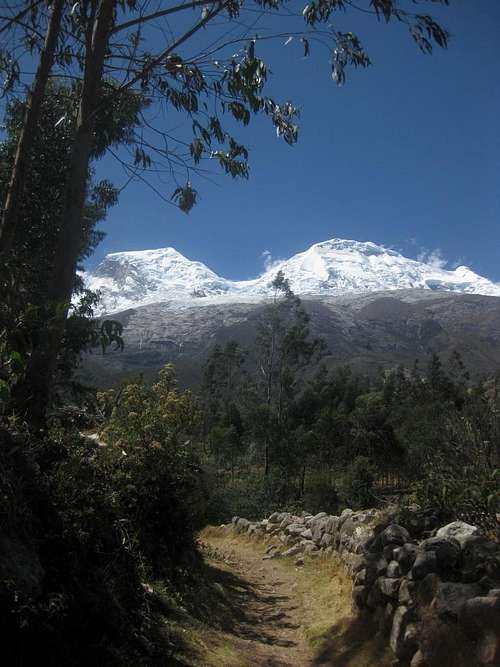

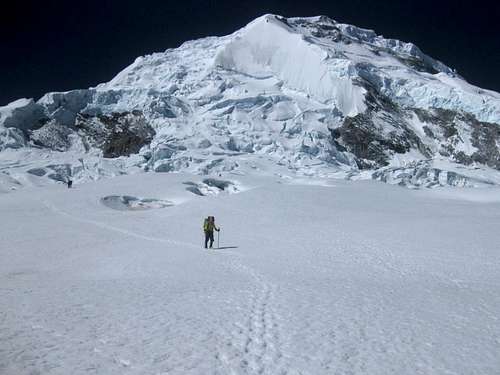
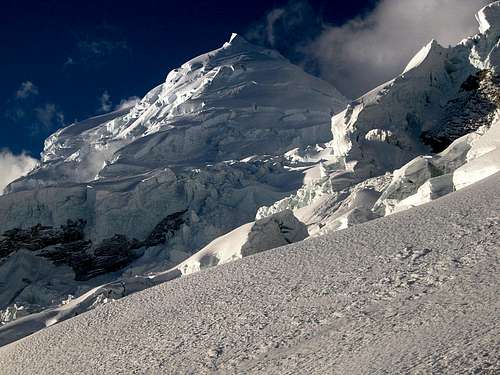
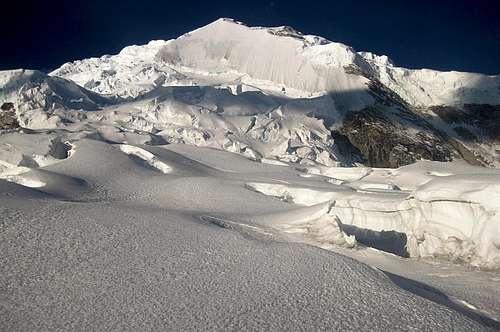
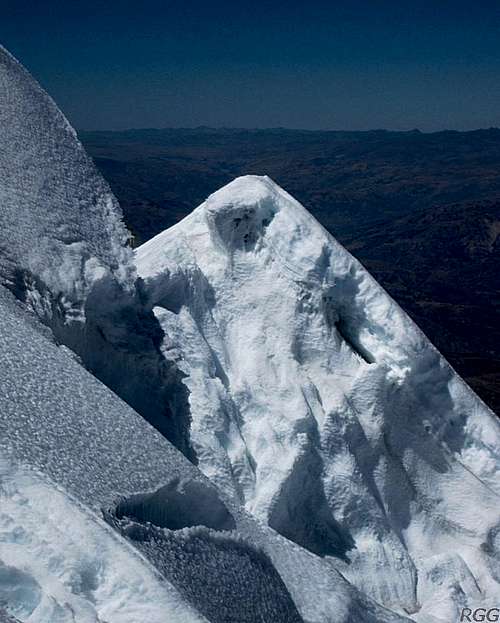
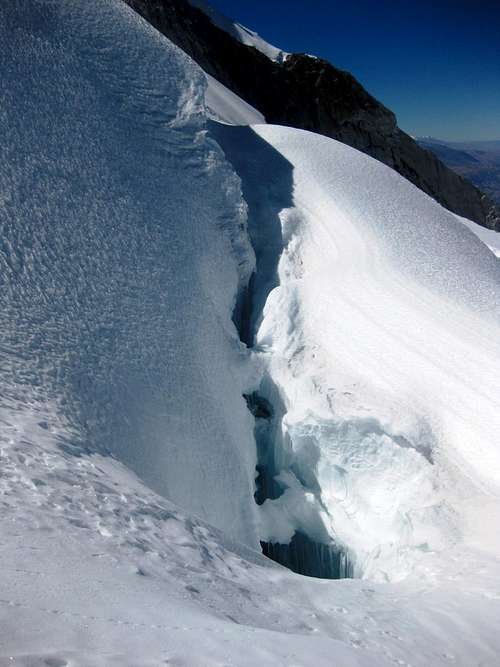
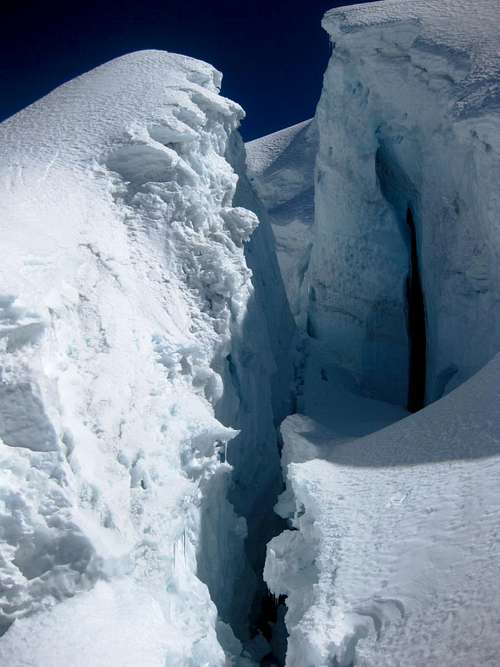
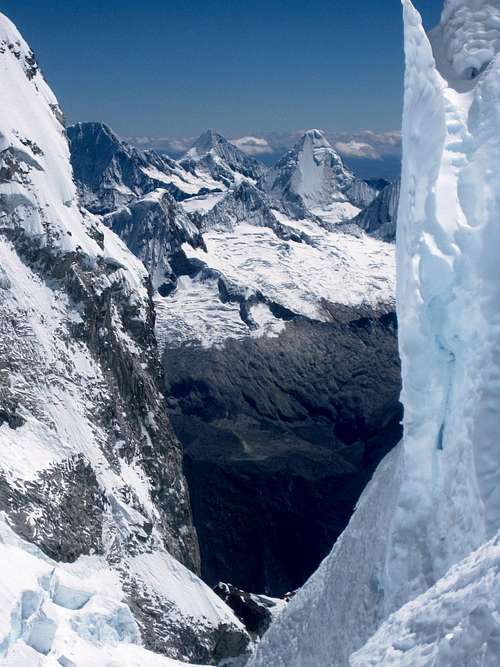
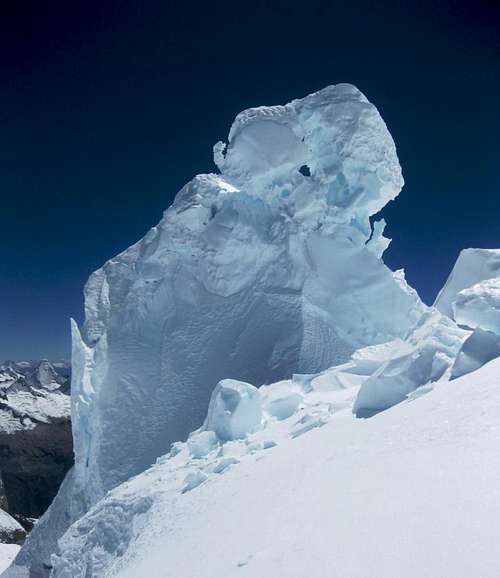
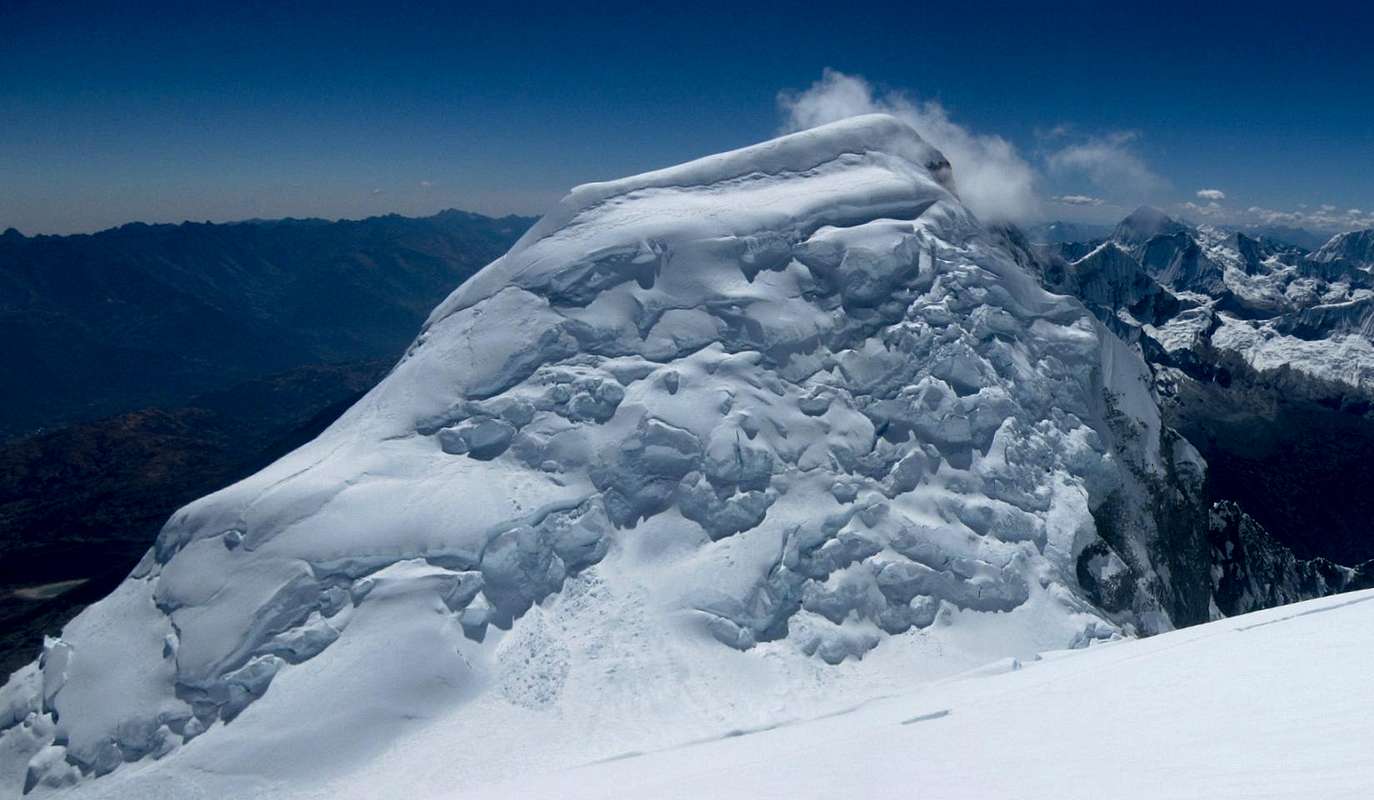
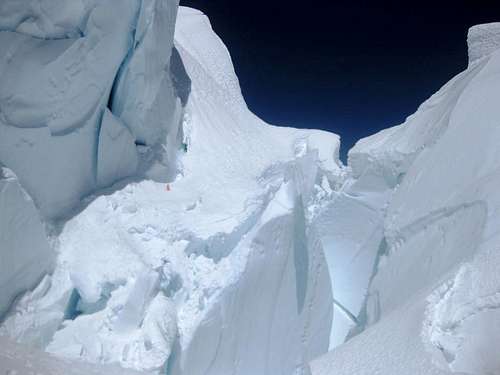
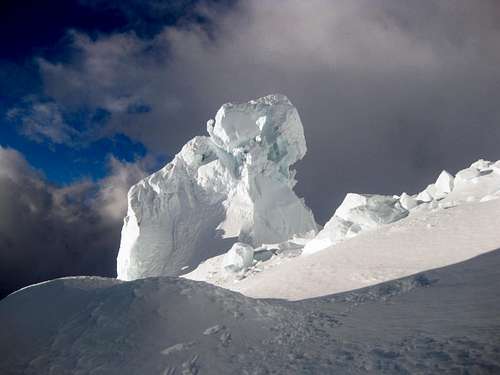

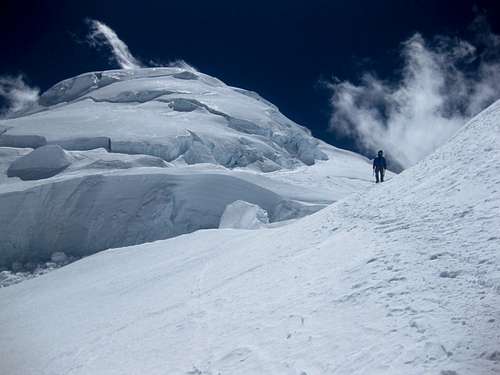


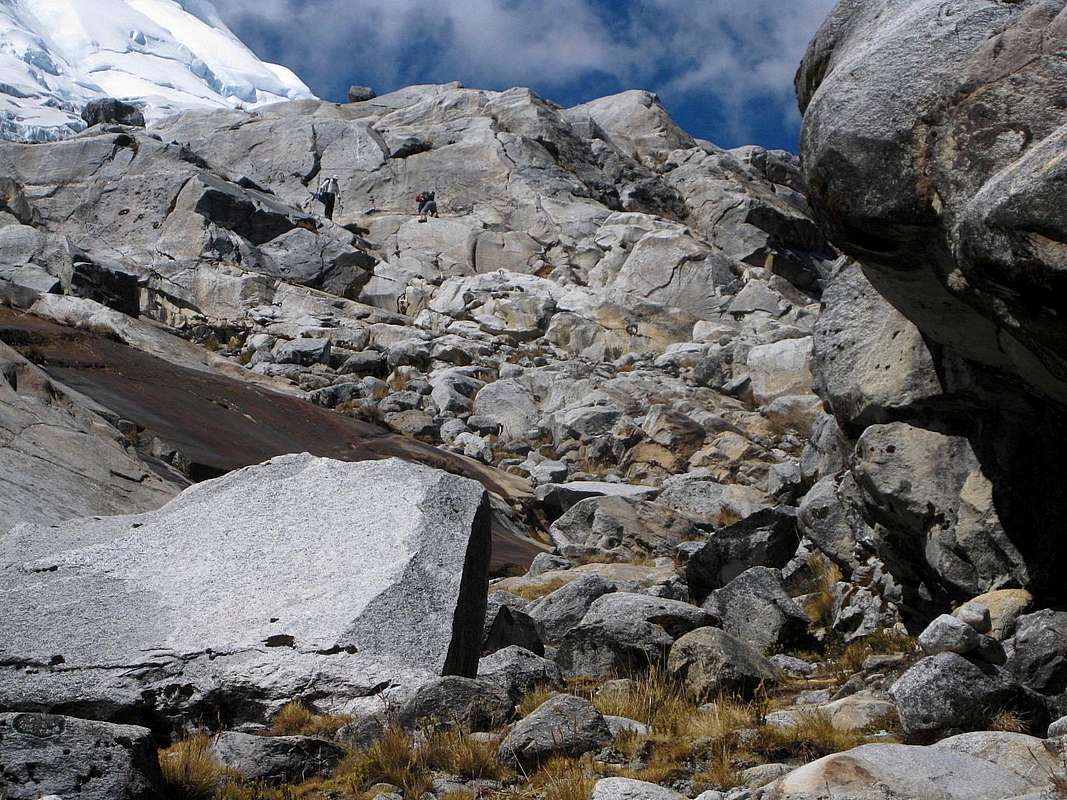


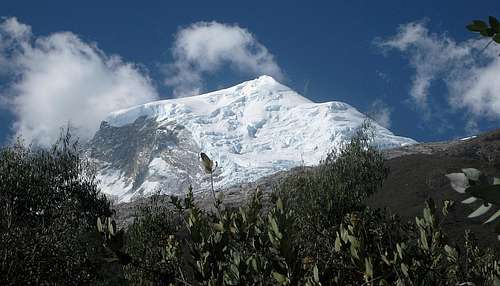






Comments
Post a Comment